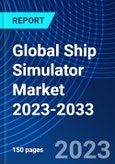The defense ship simulator is an essential training tool for naval personnel as it prepares them for the high-pressure situations that they may face during combat. The simulator provides a realistic environment that enables the trainees to practice and improve their judgement, decision-making, communication, and teamwork skills. One of the benefits of using a defense ship simulator is that it provides a safe environment for the trainees to learn without any real-world consequences. Simulators can simulate a range of situations from the simplest to complex and dangerous ones in a safe environment. As a result, trainees can make mistakes and learn from them without the fear of causing damage to the ship or endangering others.Technologies Like AR/VR and Immersion Have Increased the Effectiveness of Ship Simulator Training
Another advantage of utilizing defense ship simulators is that they can be tailored to meet the specific needs of the naval personnel. Simulators come in different specifications and can be customized to replicate different types of ships. This flexibility allows naval personnel to train on the specific scenarios they are likely to encounter on the ship they operate, enabling them to perfect their craft. The defense ship simulator also saves money and time. A simulator is significantly less expensive to operate than an actual ship, which requires ongoing maintenance, fuel costs, and logistic expenses. Furthermore, the simulator allows trainees to receive quality training without the need to disrupt live navy activities, saving time and avoiding other associated costs.
Major factors driving Ship Simulator Market Growth
Training with a ship simulator helps to maximize capital investment while also developing combat-ready troops. It is capable of placing personnel in any scenario at any time and providing more in-depth training in less time. It not only improves their talents but also provides them with awareness and experience in real-life situations. Naval forces may effectively execute a range of simulations utilizing the technology without having to pay the corresponding damage charges that can be incurred if training is conducted in real-life settings, considerably lowering the cost of training.The use of simulation technologies to boost staff confidence is becoming more frequent, and the technology is also utilized in ship design; defects in an existing military ship may be found using the same. Over the previous three decades, ship-handling simulators based on currently available technology were developed. Simulations have been utilized in a number of settings, including instructing ship operators, studying maritime mortality, and evaluating buoy placements.
Trends influencing the Ship-Simulator Market Size
The increasing demand for professional ship operators and watch captains for map charting, navigation, fire management, weather monitoring, and operating rehearsals is driving market expansion. Furthermore, strict maritime regulations demanding expert training of electronic warfare workforces has increased demand for ship bridge simulators in recent years.Shipbuilders have discovered that training on virtual reality simulators is far more successful than training on traditional marine simulators in recent years. A helmet is equipped with acoustic effects and simulation sensor systems, which are used to display video in virtual simulation devices. Using this technique, numerous people may be trained on multiple models at the same time in the same location. This is accomplished through the use of characters, which allow the user to view and interact with other participants while the training is still ongoing. Users from all around the world can take part in a similar situation.
Table of Contents
Executive Summary
The defense industry has evolved significantly over the past few decades, with defense companies using advanced technologies to train military personnel. The use of simulators has become increasingly common as the military has identified the importance of training soldiers virtually before deploying them in combat scenarios. One such type of simulator used in the defense industry is the defense ship simulator. These simulators are used to train naval personnel to operate ships in various combat scenarios. The simulators allow trainees to experience a range of situations, such as combat situations, emergency procedures, and vessel maneuvering.Table Information
| Report Attribute | Details |
|---|---|
| No. of Pages | 150 |
| Published | July 2023 |
| Forecast Period | 2023 - 2033 |
| Estimated Market Value ( USD | $ 4.32 Billion |
| Forecasted Market Value ( USD | $ 9.66 Billion |
| Compound Annual Growth Rate | 8.3% |
| Regions Covered | Global |








